| This document in the internet: www.bielefeldt.de/ladakh24e.htm |
Home |
Back to "Mountains" |
Back to Expeditions |
Map sketch |
Height diagram |
Info |
Deutsche Version |
Print version (no menus) |
| Quick overview - mountains | ||||
| date | mountain | height | gap height | |
| 02.08. | Ridge north of Upper Sapi Lake | 4785 | 85 | |
| 03.08. | southern pre-summit of Barqphoche | 4049 | 89 | |
| 08.08. | Nina´s Peak (Hemar Ri) | 5699 | 230 | |
| 12.08. | Chomo Chonkar Ri I | 6199 | 269 | Claudia, Hartmut |
| 14.08. | Chomo Chonkar Ri I | 6199 | 269 | Claudia, Nina |
| 15.08. | Pologongka | 6385 | 1265 | Claudia, Hartmut |
Ladakh 2024:
1. Trekking in the west:
Yogma La - Shinguche La (Chomotang Region)
2. Trekking in the east:
Pologongka Group
27. Juli - 18. August 2024
Claudia Bäumler, Hartmut Bielefeldt, Nina Bielefeldt
Author of this text: Hartmut Bielefeldt
Introduction
It has been six years since our last major vacation, particularly due to the very restrictive COVID-19 period and the subsequent uncertainties in planning any kind of activities. This year, the moment has finally come for a big trip again. For the fourth time, we are heading to Ladakh. Unfortunately, this time it's only the three of us, as for Henning and Marion very long trekking stages at high altitudes would meanwhile be too challenging.
Our target is the Pologongka range (between Tsomoriri (see 2015) and the Indus), as there is hardly any information available about this mountain range-except that it includes some six-thousand-meter peaks, which are technically mostly quite simple, and possibly one or two of them may even remain unclimbed. The first summit ascents in this area took place in 1997, and the second-highest peak of the group (Guide Ri) was first climbed in 2018.
This time, our trusted agency Gesar Travel has worked out a significantly different itinerary for us compared to our previous visits: we will travel overland from Srinagar to Ladakh and gradually ascend higher in the relatively unknown western part of the territory until we complete a first five-day trek in the Zanskar Range (summit ascent at the end still unclear during planning). After a rest day in Leh, we will then spend six days in the Pologongka range, with this part being organized "on the fly," as the campsites in that area are also not yet certain. The whole endeavor thus has a distinct expedition-like character.
Trip report
Friday 26 July
Friedrichshafen - ZürichOur flight from Zurich departs on Saturday at 10:50. During the planning, we overlooked that the ferry to Romanshorn on Saturdays doesn't leave until 7:20. So, we're heading out on Friday afternoon instead and staying overnight near the airport. At least this way, we are able to watch the entire opening ceremony of the Olympic Games on TV, and tomorrow we'll only have to travel 1 km to the airport.
Saturday 27 July / Sunday 28 July
Flight Zürich - Istanbul - Delhi - SrinagarAfter a short walk, we arrive at the terminal in ZRH early enough. (The tram costs CHF 4.60 for just over a kilometer, but we're too fit and too thrifty for that.) The journey to Istanbul with Turkish Airlines is comfortable. There, we spend about five hours in a huge airport built for much bigger tasks, including with equally huge prices at the snack stands. At 20:30, we continue on an IndiGo flight to Delhi, arriving after 5 1/2 hours at 5 am. Immigration is completed relatively quickly, with almost no line at the counter. However, it still takes some time to match all the fingerprints, and to align the passport photo and video recording.
The onward flight to Srinagar departs from the same terminal, and we almost managed to stay inside the building. That is, until someone directed us to a door leading outside as we were searching for the connecting flight. Instant climate shock - it feels as if you're being hit with hot, damp towels. But it's just the 29°C temperature combined with 100% humidity. For those of us wearing glasses, the immediate effect is a completely fogged-up view. Dutifully, we queue up again at the entrance door for passport control and, after fifteen minutes, are back in air-conditioned comfort. About two hours later, the check-in counter finally opens. A short flight follows, featuring a frantic breakfast onboard, as the descent begins almost as soon as we reach cruising altitude.
At Srinagar Airport, a driver sent by our trekking agency picks us up and takes us to a houseboat - or rather, to the pier on the opposite side. The houseboat package includes a tranquil crossing on a shikara. The houseboat itself is very luxurious: we have two bedrooms, a dining room, a living room, and a charming little "terrace" at the back of the boat. Dinner and breakfast are served onboard.
 Srinagar: Shikara to the house boat |
 House boat at Nigeen Lage |
Monday 29 July
SrinagarOur driver picks us up at the agreed time for a city tour. We visit the hill fort Hari Parbat, but soon after a heavy monsoon rain sets in making sightseeing a little uncomfortable. As the rain stops, we tour the large Jamia Masjid mosque (with an architecture quite unusual for a mosque), the Shah-e-Hamadan Masjid, and the Nishat Bagh gardens by Dal Lake. Apart from additional mosques and a floating vegetable market on the lake (which requires an early start), there isn't much to see in the 1.2-million city of Srinagar. Since Srinagar is located in Jammu and Kashmir, a region for which many countries have issued travel warnings or advisories, there is very little international tourism. The main visitors are Indian tourists seeking to escape the heat of their hometowns for a few days on a houseboat. While we found the daytime temperatures of around 30°C more tolerable than Delhi's, we as Central Europeans can hardly describe this as pleasant summer weather.
 Hari Parbat |
 Jamia Masjid |
 Nishat Bagh, one of the Mughal Gardens around Srinagar |
 Nigeen Lake |
Tuesday 30 July
Srinagar - Zoji La - Kargil - ShergolOur guide, Norbu, stopped by yesterday evening to discuss the plans for the first few days. At 8 a.m., we are picked up and begin our drive to Ladakh on National Highway 1. Starting in Srinagar (1700 m), we follow a lush green valley with forested slopes up to Sonamarg (2600 m). A rather unsettling sight is the nearly continuous presence of armed soldiers along the roadside, standing every 300 meters or so. However, this could be related to the large pilgrimage festival happening near Sonamarg.
Over the course of these 80 kilometers, there are also other things which we have to get used to. Most important, Indian road traffic. The concept of courtesy, which still exists sporadically in Germany, seems entirely unknown. Every tiny gap is exploited to gain even the slightest advantage. Honking, swerving into oncoming lanes, and then seeing how things play out seems to be the norm. If someone is approaching head-on, perhaps they'll give way? If not, you can always swerve back to the left in the last second. The BRO (Border Roads Organisation) has put up numerous signs intended to discourage such recklessness. My favorite: "Drive like hell and soon you are there." Another, less clear one: "Please follow traffic rules" - do such rules even exist here? In any case, there is no boredom, although our driver is relatively gentle compared to others.
The first and most important pass on this route is the Zoji La. Ladakh is accessible by only two roads: NH1 from Srinagar and NH3 from Manali. Both traverse several extremely high passes and are closed in winter. During the short summer season, all goods transported into Ladakh travel along these roughly 400-kilometer routes by truck. Accidents are common due to driver fatigue, poor vehicle conditions, or adverse weather. Currently, the Zoji La is being tunneled, with completion expected in 2026. This will provide Ladakh with its first year-round road connection. The construction site is impressive, comparable in scale to Austria's Arlberg Tunnel (including its access roads). For India, it is also a highly significant strategic project.
 Zoji La pass road |
 |
 Zoji La |
After crossing Zoji La (3550 m), the landscape changes dramatically. Until now, we had been driving through terrain resembling the pre-Alpine region, with forests and meadows similar to the Bregenzerwald. Suddenly, it becomes barren and dry. We pass through Drass, known as the coldest inhabited place in India. Its unique location subjects it to winter temperatures often below -25°C, with record lows reaching -45°C. Politically, Drass is highly exposed, as the Line of Control is only a few kilometers away. In 1999, the last war with Pakistan took place here. The district capital, Kargil, once held significance as a hub for caravan routes between Kashmir, Ladakh, and Baltistan. Today, however, aside from a market, there's not much to see.
Shortly after Kargil, we encounter a traffic jam. We hear that a man is been throwing stones at cars. Sure enough, a visibly aggressive man is running toward us holding a rather large stone. When he's about 50 meters away, our startled driver executes a remarkably quick U-turn. Along with everyone else stuck in the jam, we bypass the problem via a side road known to our local companions. Just another adventure to add to the list...
At Shergol, we turn into a side valley and arrive at the small village of Serjing (3250 m), where we settle into a homestay. We make ourselves comfortable in a cozy triple room.
Wednesday 31 July
Urgyen Dzong (acclimatization hike), 400 HMFrom the parking lot above the "village" (3420 m), we hike through a very narrow gorge along a well-maintained path. The trail is currently being repaired in several places in preparation for a major pilgrimage festival taking place in two weeks. At 3700 m, we reach a small monastery perched on a mountain ridge. Across the valley, embedded in the rock, lies the Urgyen Dzong hermitage cave, where, according to legend, Padmasambhava meditated in the 8th century and thereby freed the region from evil spirits. After exploring the monastery and taking a lunch break, we begin our return journey. The weather is sunny and very warm, and at this altitude, there is hardly any shade. Only a few trees grow here, and they are found exclusively in spots where spring water is found.
 Way through the gorge to the hermitage |
 |
 Ugyen Dzong |
Thursday 01 August
Fahrt Shergol - Mulbekh - SapiFrom the homestay, we return to the main valley, stopping for a visit of the hermit monastery at Shergol, the large Buddha statue at the entrance to Mulbekh, and the monastery above Mulbekh. By now, we're starting to feel a bit "over-monasteried", so we're not too disappointed when the monk with the key of the last monastery cannot be found.
We drive back via Shergol towards Sapi La (4400 m). The road is narrow but in excellent condition, likely only 2-3 years old. It seems the BRO (Border Roads Organisation) still has plenty of work extending infrastructure into even the most remote corners of the country. Understandably: Who would nowadays want to live in a hamlet that requires a 2-3 day trek to reach?
On the other side, we arrive in Sapi, the location of our homestay is somewhat unclear. At the end of an adventurous track, we wait a bit until Norbu guides us to the right house. Our luggage is already there - the helpers have carried it up another footpath.
This homestay is a farmhouse situated at 3980 m, surrounded by barley fields. Life is simpler here: the toilet is an outhouse, and the path to it leads around the outside of the house. Washing water comes from a stream next to the house. Dinner and breakfast are good and plentiful, and we're gradually getting used to Ladakhi cuisine.
The farmers here keep several yaks. A yak cow and her calf are in the stable next to the house, and the baby yak is adorably cute. After this night, we also understand why they're called "grunting oxen"!
 The large Buddha of Mulbekh |
 Homestay at 4000 m |
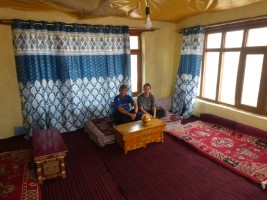 a comfortable room |
 Yak and little yak |
Friday 02 August
Acclimatization hike to the upper Sapi Lake, 800 HMShortly after setting out, we encounter our first technical issue: Nina's MP3 player battery is empty. Nonetheless, we don't turn back. Instead, Nina strikes up a conversation with Norbu and us. We trek uphill across seemingly endless grassy slopes. Above 4000 m, the landscape is adorned with lots of blooming flowers - here the grazing areas begin. It takes us three hours to finally reach the glacial lake at 4700 m. From his backpack, Norbu magically produces a melon far larger than any of us can manage to eat. (The remainder, of course, is carefully packed and brought back down.) Amidst a stunning high-altitude alpine landscape, we climb the small hill next to the lake, reaching 4785 m, before descending again to the homestay.
 walking towards Sapi Lake |
 Sapi Lake, 4700 m |
 |
 Edelweiss |
We continue our journey over the Namika La Pass to the next homestay in Yogmal (3630 m). Here, we once again enjoy the luxury of a bathroom with a seated toilet and, apart from brief interruptions, a reliable electricity supply. In the evening, a longer rain shower passes through.
 The car is coming from the parking, we join here |
 Driving towards Namika La |
Saturday 03 August
Yogmal (Bodhkarbu), yearly festival of the nunneryBarqphoche pre-summit, 500 HM
Our guide learned at short notice that the annual monastery festival is taking place at the nearby nunnery in Bodhkarbu. The roughly three-hour mask dance is a fascinating spectacle, although we cannot really follow the details of the performance.
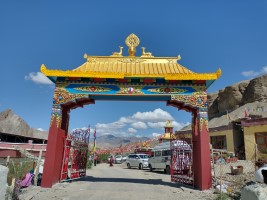 Nunnery Bodhkarbu |
 Mask dance at the yearly festival |
 |
We return to the homestay around midday, just as a brief but intense thunderstorm causes the streams to rise rapidly. In the barren landscape, water quickly flows over the surface and collects in the valley, sometimes resulting in damage to paths or bridges.
In the afternoon, we hike up a small sub-peak (4049 m) of a mountain marked as Barqphoche on the map. Since the route follows the ridge, we remain safely away from any potential flooding.
Sunday 04 August
Drive to KanjiWe continue our journey towards Leh but turn off before the third pass (Fotu La), staying in the valley. At the end of a very narrow gorge with a bumpy road, we reach the tiny village of Kanji (3840 m). Here, the rest of the team joins us: cook Namgyal and helper Tashi. Our tents are set up, and the kitchen is established in a small room of a building that some time ago has seen better days. Still, the roof is intact, which is the most important thing given the rainy afternoon weather. One room also houses a "store," where we take shelter and wait out the heaviest shower.
 The team is coming: Helper Tashi and cook Namgyal |
 Campsite in Kanji (3840 m) |
 Dinner "inside", outside it is raining |
Monday 05 August
Trekking day 1: Kanji (3840 m) - Yogma La (4730 m) - Shillakong (4500 m)14 km / 1100 HM
The trekking routine begins at 7 a.m. with morning tea. Then we pack our belongings and head to breakfast by 7:30. The horseman arrives with horses and donkeys; while we eat, our tents are taken down. By 8 a.m., we set off with Norbu, while the rest of the camp is packed up. Later in the day, the caravan overtakes us to set up the next camp.
We hike through a very flat valley, initially along a somewhat monotonous dirt road. Soon, though, things get more interesting: we have to cross a knee-deep stream. After passing Dumbur Alp, where sheep and goats graze, we continue toward the pass with magnificent views of dramatic rock formations in various (and mostly intimidatingly steep) shapes and colors. Shortly before the pass, a brief rain shower catches us. As we reach the pass (4730 m), the pack animals and their load also arrive.
On the map, the descent seemed short, but in reality, we traverse steep slopes for a long time, high above deeply incised gorges. Rain begins to fall again, making the stream crossing just before the campsite quite an adventure. We can't hope for the water level to drop because the rain will likely cause it to rise even further throughout the day. So, we must cross while it's still manageable. We reach the campsite together with the pack animals, where, fortunately, a shepherd's tent is already set up, providing us with temporary shelter. The rain gradually subsides, and soon the camp is ready. By dinner time, we can sit outside and enjoy our meal.
 view back after the river crossing |
 the alp Dumbur |
 The valley widens |
 Just before the pass |
 The river is already quite high |
 At dinner time it is nice again |
Tuesday 06 August
Trekking day 2: Shillakong (4500 m) - Shinguche La (5146 m) - Spangthang Tokpo (4710 m)10 km / 800 HM
The morning routine is the same as yesterday. The path is a more or less a traverse, crossing several side streams, which can be handled with regular shoes. After that, we go moderately steep through meadowland, passing many rock spires in the foreground, then up steep scree slopes to the Shinguche La, 5146 m. On the other side, we descend initially over monotonous scree slopes, then alongside a stream flanked by impressive rock formations. The campsite is at 4710 m, just before a stream crossing that will likely be easier tomorrow morning.
In the afternoon, Claudia explores a possible access route to Nigutse South up to 5100 m. The mountain looks quite interesting, but no suitable campsite can be found higher up in the scree-covered terrain. From here, it would be too far for a single day, considering our still relatively poor acclimatization, with over 1000 meters of elevation to climb.
Wednesday 07 August
Trekking day 3: Spangthang Tokpo (4710 m) - Spang Nala (4840 m)7 km / 400 HM
Amidst the bleating - we are accompanied by a herd of about 300 sheep for most of the journey - we head south, where the base for our mountain ascent is to be established at Spang Nala. The path undulates gently for about 5 km, until we face the problem of the day: the river crossing at Spang Nala is just about waist-deep and quite fast-flowing, with the typical glacier stream temperature.
On the other side, our campsite is reached shortly afterward, and the other three with the horses soon arrive and set up the tents. The afternoon is rather cold and windy, but the spot offers beautiful views of glacier-covered mountains in the background, as well as our destination for tomorrow, which rises directly behind the camp.
 Breakfast |
 Soon they´ll go back to work |
 Strange rock towers interrupt the plateau |
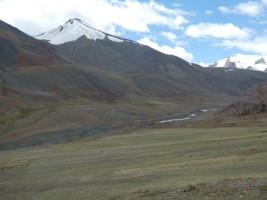 We will visit (and name) this mountain tomorrow |
 The toughest river crossing of this journey |
 Camp at 4840 m |
Thurday 08 August
Trekking day 4: Hemar Ri (Nina´s Peak), 5699 m7 km / 900 HM
We depart at five in the morning, by which time it is reasonably light. Through more or less steep scree slopes, we search for the best access to the northwest ridge of our mountain. The ridge itself is a very simple scree crest. Unfortunately, the clouds are steadily gathering, so we have almost no visibility and cannot discern where the actual summit is located. At 5620 m, the northwest ridge joins from the left, and from here the ridge gradually ascends further south. After two small summits, we reach what seems to be the highest point, with the GPS showing 5699 to 5700 m. There are no signs of previous visits: no prayer flags, no cairn, and nothing that looks like a fallen cairn. So, we're likely the first to reach this summit. A strange feeling.
We build a small cairn - there's plenty of material - and place a note with our names, wrapped in a plastic bag, inside. Unfortunately, we don't have any prayer flags with us; we had planned to buy some in Leh. We can enjoy a bit of a view in different directions, as much as the clouds allow, before we descend by the same route. The descent takes an hour and a half; the ascent had taken four hours.
 |
 |
 Search for the best access |
 The summit ridge seems endless. |
 |
 This will probably be the summit |
 View to the south. Many mountains, few names. |
 Southwest, mountains at the head of the Spang Nala valley |
 The first cairn on this mountain |
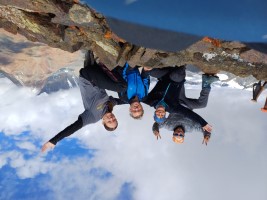 |
 Descent |
 Head or (our) Spang Nala Valley. There would be still quite a lot to be done. |
The rest of the day is, as one might say, "at your leisure." Rest, sleep, eat, play Monopoly or Uno.
Friday 09 August
Trekking day 5: Descent to the road at Sirsir La; drive to Leh5 km
A relaxed hiking stage: an hour and a half descent through the valley to the road at Sirsir La. No river crossings or other adventures; along the way, we encounter a shepherd, about 300 sheep, and several goats, but no one else. Also the previous days, there had been no one else around except for us and a few local herders.
The horseman takes the remaining food and sets off with his animals back to Kanji, retracing the same route we followed on our trek.
Soon, a minibus arrives, and we are all driven to Leh with our gear. The road to Hanupatta starts as a dirt road, but construction is going on everywhere. There are probably more guest workers from Bihar in the whole valley than local residents. The valley narrows into a very tight gorge; after 30 kilometers, we reach NH1 - finally, a two-lane road again. The route now mostly follows the Indus River uphill. Although there are occasionally some irrigated areas along the river, there are also gorge-like sections in between. There's not much usable space for settlements in this area.
After about five hours of driving, we arrive in Leh at the Yartsa Guesthouse, where our landlady Diskit greets us warmly. In the city, we find that the Penguin Restaurant has been replaced by a new name, "Lamayuru," but at least there is some semblance of Western food there (although it doesn't quite compare to the Chicken Cordon Bleu from the Penguin).
 Brilliant morning: Chomotang is just over 6000 meters high. |
 We walk downstream towards the road. |
 The first sections of the road are quite rough |
Saturday 10 August
Rest day in Leh
Rest day, with no set sightseeing program - we've already seen quite a bit in Leh. A special luxury is that we get our laundry washed at the guesthouse, many thanks to our landlady Diskit. We spend the day strolling through the market, where a handicraft exhibition is taking place, and visit a few shops.
A couple of notes: Leh now has a supermarket, offering many regular food items at MRP (Maximum Retail Price - which is printed on the products and is usually quite affordable), but also many imported goods like cheese and chocolate, which are sometimes sold at adventurous prices (not labeled, so you have to ask). There is also a Decathlon store on the outskirts of town, though its selection is still quite limited (a few jackets hanging in the sales area).
At the Beer Shop, we run into the shopkeeper from Kanji again, who buys the beer here that he sells in his store in Kanji.
For dinner, we head to 'Lamayuru' with Norbu.
 Yartsa Guesthouse, Leh |
 The beautiful garden of the guesthouse |
 Picture with Diskit, the guesthouse owner |
 Bazar / pedestrian zone, Leh |
Sunday 11 August
Drive over Taglang La to Pologongka La (4980 m)Trekking day 1: Ascent camp 1 at Pologongka (5280 m)
2 km / 300 HM
Our guide Abhishek, who will accompany us on the next trek, picks us up at 8 a.m. Namgyal and Tashi are with us again. We drive via Karu and Upshi on the Manali-Leh Highway, passing the 5330 m high Taglang La, heading towards Tsokar - this route is familiar to us from our Ladakh trip in 2015. This time, we follow the northern edge of the salt lake towards Pologongka La. The road is narrow but has apparently been newly paved, although some work is still in progress.
At the pass (4980 m), we start with Abhishek in cloudy weather to find a campsite. The rest of the team waits by the road for the pack animals. After an hour and a half, we find a suitable spot at 5280 m. It starts to rain, but the horses are still nowhere to be seen. We wait for an hour under an umbrella until the team finally arrives. But then, the camp setup proceeds quickly and efficiently.
Unlike the first trek, we are not following an established trekking route here, but instead exploring the little-known Pologongka mountain range. As a result, no one knows the area well, and there are no established campsites with level ground to pitch a tent. The best compromise is a stone-free area with a slope of about 5 to 10 degrees for our tent. The night is not particularly comfortable as we constantly slide toward the tent entrance with our sleeping mats.
Monday 12 August
Trekking day 2: Chomo Chonkar La, Chomo Chonkar Ri I (6199 m) and back10 km / 950 HM
During the night, there was some fresh snow above: The mountains are dusted with snow, and the weather looks unsettled. We explore the further course of the valley. Occasionally, we spot trail marks and cairns, but overall the high valley is a real scree desert, interrupted by very sparse vegetation. At the end of a flat scree plain, we reach the pass (5815 m), from where we get a view of the Chomo Chonkar Lake on the other side. At 5650 m, it is one of the highest lakes in Ladakh, about a kilometer long.
We don't descend into the enclosed basin towards the lake because we want avoid the climb up on the way back . Since the weather, despite the clouds, looks quite decent and the 550 meters of elevation gain to this point were fairly quick, we head north towards the nearest peak. (The mountain to the south looks quite inaccessible with its steep gravel slopes.) After two hours of a strenuous but straightforward scree slope, we reach the summit of Chomo Chonkar Ri I; the GPS shows 6200 meters. Despite some clouds, we have a decent panoramic view, and from here, we can finally get a good look at the main goal, Pologongka.
For the descent, we choose the northern ridge, crossing a small, almost crevasse-free glacier to the pass below the Pologongka, then passing a frozen lake as we make our way back through long scree plains and valleys to our campsite.
Nina had a poor night's sleep and takes a rest day at camp.
 Further up, there was some snow. |
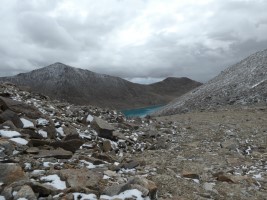 Chomo Chonkar Lake, 5650 m |
 We go up further through the scree |
 Chomo Chonkar Ri I, 6200 m |
 |
 Descent to the other side |
Tuesday 13 August
Trekking day 3: camp 1 - camp 2 - Chomo Chonkar La - camp 25 km, 550 HM
This night there was some frost, but inside the tent, it's still quite cozy at 8°C.
Since the camp is too low for climbing Pologongka, today we move to a campsite 300 meters higher. After yesterday's inspection, there is a camping possibility at 5650 m. Originally, Abhishek wanted to go even higher, but the horses cannot climb through the boulder terrain into the high valley. Also, his planned overnight height of 5900 m would probably not be very comfortable for anyone and is unnecessary given the summit heights.
Claudia and Nina continue up to the Chomo Chonkar La to get a view of the lake. In the afternoon - fortunately, after the camp is set up - there are some hail showers, but the sun breaks through in between. In the evening, we find a small mouse in the vestibule of the tent, looking quite hungry.
 In the afternoon again there is a snow shower |
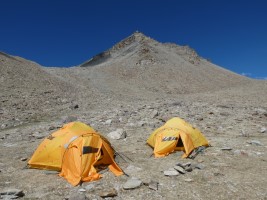 Later it is nice again. |
 Monopoly at 5650 m |
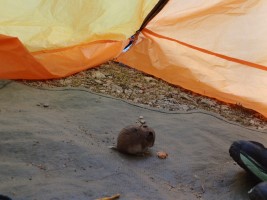 A small hungry visitor |
Wednesday 14 August
Trekking day 4:Hartmut: Attempt at Chomo Chonkar Kangri (up to 5935 m), 3 km / 300 HM
Nina, Claudia: Chomo Chonkar Ri I (6199 m), 7 km / 600 HM
Summit day for the main peak of the group, Pologongka. Since Nina slept very poorly, we spontaneously change plans: I attempt Chono Chonkar Kangri with Abhishek, starting at six in the morning. The weather doesn't look very promising, it is cloudy, and there's a strong wind. The north face of the mountain consists mostly of loose debris, making progress very slow. The snowfields are just a thin layer of snow on hard ice, which at such steepness (>45°) isn't ideal. Thus, this attempt ends at 5935 m, and unfortunately, we won't find out if this mountain is still unclimbed. If it is, it will remain so for now.
With a better route choice further to the left, we might have made it a bit higher, but it would likely have become just as steep and loose further up. So, by eight o'clock, we're back in camp.
Claudia and Nina depart at nine with Abhishek for Chomo Chonkar Ri I. There seem to be some differences in route assessments between Indian guides and German climbing instructors. The latter prevail, and after 3 1/2 hours, they reach the summit, marking Nina's first 6000-meter peak.
Luckily, they are back in camp by 14:00: After it had been sunnier around noon, hail and rain intermittently continue for the rest of the afternoon.
 |
 Beyond the moraine slope, we reach the ice lake |
 Ice lake (5930 m) |
 Last meters at Chomo Chonkar Ri I |
 Nina´s first 6000 m peak |
 Descent towards the lake resp. Chomo Chonkar La |
Thursday 15 August
Trekking Tag 5: Pologongka (6385 m)8 km / 800 HM
Nina's enthusiasm for another 6000-meter peak is limited, so Claudia and I go without her to Pologongka with Abhishek. After crossing the frozen lake, we quickly reach the glacier and cross a crevasse-free glacier basin to the eastern ridge of the Pologongka. The 250 meters of elevation along the ridge seem endless, and the altitude is very noticeable. The route is not particularly difficult, and we can go without a rope: the few small crevasses are easily visible. Towards the end, the ridge flattens out and becomes the summit plateau. The highest point is marked with prayer flags, at 6385 meters - our highest peak since Ojos del Salado (which was already 18 years ago).
Once again, some clouds have gathered, making it difficult to appreciate the panoramic view. To the south, we can clearly see Tsomoriri, Spangnak Ri, and the Mentok and Gyama ranges, where we had been in 2015; to the left of Tsomoriri is the Chamser-Lungser range, which has been off-limits to tourists for 10 years. Beyond the Indus, only the pyramid shape of Chakula can be identified. We hang up our prayer flags and set off on our return after half an hour. It takes us less than two hours to descend back to camp.
 Ascent to Pologongka |
 Chomo Chonkar Ri I |
 Beginning of the northeast ridge |
 a frew small crevasses |
 The summit is a large plateau. |
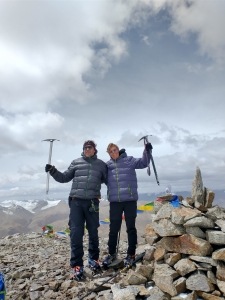 Pologongka (6385 m) |
 View to Tsomoriri and Gyama Peaks (visited in 2015) |
At camp, we are welcomed with juice and are immediately offered the missed lunch; it seems difficult to explain that on an exhausting day at high altitude, one doesn't have much of an appetite. Resting in the tent doesn't help either: After a short time, I receive a "free tent delivery" of noodle soup, noodles with salad, black tea, and melon.
 Nina, Abhishek, Tashi, Namgyal, Claudia, Hartmut |
 We also get a cake with our peak heights |
Friday 16 August
Trekking day 6: Descent to the road at Pologongka La, 4 kmDrive back to Leh
Breakfast at 7:30, and we're ready to leave by 8:00. Since the camp needs to be packed up first, we don't leave until 9:00. After an hour, we reach the pass and the road and wait for a while until the loads arrive and the horses are unloaded. Then the waiting continues, as no car is in sight. Since there's no mobile reception at the pass, Namgyal is sent with a passing vehicle to clarify the situation in the next village.
The car finally arrives at 12:00, unexpectedly from the east. There were some traffic problems at Taglang La, so the driver had to take a 200-kilometer detour. The drive to Leh - 170 km - takes four hours, ending in heavy traffic. We are happy again that we don't have to drive ourselves.
 Soon the pass is in sight |
 Our valley, Pologongka itself is not visible |
 Waiting for the bus |
Saturday 17 August
Rest day in LehRest day, souvenir shopping. Dinner at the Bon Appetit restaurant (located northwest of Upper Tukcha Road), which we hadn't discovered before: They offer almost Western cuisine, and even beer.
 Leh |
 Breakfast in the guesthouse |
Sunday 18 August / Monday 19 August
Flght Leh - Delhi, Delhi - Taschkent - Frankfurt
Luckily, I saw last night while checking emails that our flight from Leh to Delhi was rescheduled from 14:00 to 10:20, otherwise we would have had a nasty surprise at the airport. Probably, the flight load was too low, so they consolidated the flights.
After an hour of flight time, we arrive at DEL and, amid the usual chaos, find a semi-official taxi with a guaranteed fare that takes us to our pre-booked hotel. Our international flight departs at midnight, so we technically don't need an overnight stay in Delhi. However, a hotel room was cheaper than luggage storage for 12 hours. The hotel is, of course, of medium standard, but we can spend the afternoon there comfortably. Any ambitions for sightseeing have vanished after a brief excursion to the nearest grocery kiosk: The weather is still the same as it was three weeks ago, and we don't voluntarily leave the somewhat air-conditioned room anymore.
 Flight over the Himalaya to Delhi |
 Delhi |
Three hours before departure time, we are back at the airport. We quickly find the check-in counter, which happens to have the longest line in the entire airport. It seems like everyone has a huge amount of excess baggage, which then has to be repacked, weighed again, and repacked once more, until they eventually disappear to the excess baggage counter to pay. These people, however, clearly have more than 20 kg with them. Our problem, however, is different: After an hour, it's our turn, and we are confronted with the question of how we would like to pay for our excess baggage, as our travel luggage is only booked to Tashkent. With the help of the booking printout, we can prove the opposite, but convincing the Indian booking system needs several higher and higher airport employees.
The passport control takes another three-quarters of an hour. After that, there's the security check, which takes half an hour. Of course, the number of batteries is once again questioned and carefully noted in a booklet, with the exact purpose for each battery we have.
So, we reach the gate just before boarding time, extremely hungry - we had planned to find a restaurant in the duty-free area for dinner. Instead, we quickly grab a few pastries from the bakery stand at the gate to avoid starving.
After the boarding process, where the pushing Uzbek grandmothers with their oversized hand luggage were sorted out by the staff, we finally sit down on the Uzbekistan Airways flight to Tashkent. Now everything will be fine: The safety video is quite entertaining (here's the link to the ![]() YouTube video), and on the two-and-a-half-hour flight, we are served a full meal.
YouTube video), and on the two-and-a-half-hour flight, we are served a full meal.
In Tashkent, we spend three hours in transit, then followed by a seven-hour flight to Frankfurt with dinner and breakfast. From Frankfurt, we then take the train home without any issues. This day, of course, feels quite long again: From Leh, we were traveling for 34 hours in total.
It was sometimes exhausting, sometimes far beyond the comfort zone, and after three weeks, we are glad to be back in the familiar surroundings of home. Still, looking back, it was a great vacation with amazing challenges and successes.
Technical hints about the images
After clicking onto an image, a larger version (height 768 pixels) will be opened in a new tab in the browser.
In this window, a manual or automatic slide show can be started:
- click onto the image -> next image
- click onto right arrow -> next image
- click onto left arrow -> previous image
- click onto clock -> next image, and automatically every 5 seconds the next image will be loadad. This can be interrputed again by one of the above mentioned clicks. The automatic slide show needs JavaScript.
If you don't like the image height 768 (e.g. on notebook or netbook computers): Normally you can change the scaling of the contents using Ctrl-"+" oder Ctrl-"-".
For the translation from German to English, I incorporated suggestions made by ChatGPT but not without critical questioning.Home |
Back to "Mountains" |
Back to Expeditions |
Map sketch |
Height diagram |
Info |
Deutsche Version |
Print version (no menus) |
Hartmut Bielefeldt
Galleyenstrasse 19/2
D-88048 Friedrichshafen
© 2024 Hartmut Bielefeldt
![]() This page is confirmed to comply with the HTML 4.0 standard.
This page is confirmed to comply with the HTML 4.0 standard.
Last updated December 21, 2024 by Hartmut Bielefeldt














